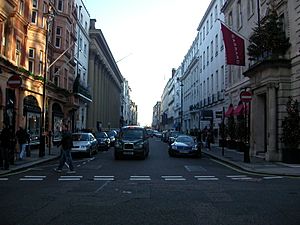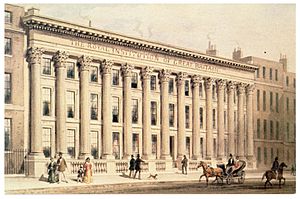Albemarle Street facts for kids
Albemarle Street is a famous street in Mayfair, a central part of London. It's just off Piccadilly. This street has a rich history, connected to famous people like Lord Byron, whose publisher, John Murray, was located here. It's also linked to Oscar Wilde, who was a member of the Albemarle Club. A disagreement he had there led to a famous court case. Today, Albemarle Street is known for its many art galleries, and the well-known Brown's Hotel is also found here.
Contents
History of Albemarle Street
Albemarle Street was built by a group of developers led by Sir Thomas Bond. In 1684, they bought a large house called Clarendon House from Christopher Monck, 2nd Duke of Albemarle. The house was in bad shape because its owner had spent too much money. It was sold for £20,000, which was less than he had paid for it, even though land in the area was becoming more valuable.
The developers tore down Clarendon House and started building new streets. At that time, the area behind the house was open fields. The group also built other nearby streets like Old Bond Street, Dover Street, and Stafford Street.
Albemarle Street became the very first one-way street in London. This decision was made to help traffic flow better. What happened was that a scientist named Humphry Davy gave popular lectures at the Royal Institution on the street. So many horse-drawn carriages brought eager people to his talks that they caused huge traffic jams! To stop this from happening again, Albemarle Street was made a one-way street.
Famous People and Places
Many important people and places have been connected to Albemarle Street over the years.
Early Residents
- Robert Harley, 1st Earl of Oxford and Earl Mortimer (1661–1724): A key minister for Queen Anne, he lived and died in his house on Albemarle Street in 1724.
- Victor Spencer, 1st Viscount Churchill (1864–1934): He was born at 32 Albemarle Street. He served as a Page of Honour for Queen Victoria and was a British nobleman.
The Albemarle Club
The Albemarle Club was originally on Albemarle Street before moving to nearby Dover Street. Oscar Wilde, a famous writer, was a member. In 1895, a disagreement he had there with the Marquess of Queensberry led to a well-known court case.
John Murray Publishers
The famous publisher John Murray was located at 50 Albemarle Street for many years. After Lord Byron died, some of his important papers were sadly burned in a fireplace on the first floor. Sir John Betjeman, a well-known poet, was another author published by Murray. They also published Charles Darwin's famous book, The Origin of Species, in 1859.
Grillion's Hotel
A Frenchman named Alexander Grillion opened Grillion's Hotel at No. 7 in 1803. Louis XVIII, the King of France, stayed here in 1814 before returning to France. The Royal Thames Yacht Club was later based in this building.
The Royal Institution
The Royal Institution is at 21 Albemarle Street. It's a very grand building with many classical columns at the front. The Institution was founded in 1799 and has been made much larger over time. It is now a Grade I listed building, which means it's very important historically. Because the Institution's science lectures were so popular, Albemarle Street became London's first one-way street to help with all the traffic.
The X Club
The naturalist Thomas Huxley started a dining club called the X Club. They first met on November 3, 1864, at St George's Hotel on Albemarle Street. This club had nine members who strongly supported evolution and the ideas of Charles Darwin. They became very important in science during the late 1800s.
St George's Chapel
Reverend William Webb Ellis (1806–1872) was an Anglican clergyman. He is famous for supposedly inventing Rugby football while he was a student at Rugby School. He later became the chaplain of St George's Chapel on Albemarle Street. He even published some of his sermons from there. The chapel was built on land leased by Lord Suffield, who lived on Albemarle Street.
The Mellier Building
The beautiful Beaux-Arts building at 26b Albemarle Street was originally the home and showroom of Charles Mellier & Co. Charles Mellier was a very successful cabinet maker and decorator from France. One of his most famous jobs was for the large ship RMS Mauretania.
In 1921, Lendrum Motors moved into the ground floor and basement of the Mellier building. They turned it into a stylish car showroom called ‘Buick House’. From 1923, it was known as Lendrum & Hartman Limited. This company was a major importer of Buick and Cadillac cars from North America. It became a very important car dealership, even selling a Buick to the Prince of Wales (who later became King Edward VIII) in 1935. Today, the building is called the Mellier again and has been changed into apartments.
Modern Architecture
In the 1950s, the architect Ernő Goldfinger designed two office buildings at 45–46 Albemarle Street. His design was praised because it fit in well with the older Georgian buildings around it.
Oswald's Club
The private members' club Oswald's is located in a townhouse at 25 Albemarle Street.
Art Galleries
Albemarle Street is home to many art galleries. Here are some of them:
- Connaught Brown, 2 Albemarle Street
- The Archeus Gallery, 3 Albemarle Street
- Marlborough Fine Art, 6 Albemarle Street
- W. H. Patterson Fine Arts, 19 Albemarle Street
- Phillips de Pury & Company, 25–26 Albemarle Street
- Mazzoleni Art, 27 Albemarle Street
- The Grosvenor Gallery, 37 Albemarle Street
- John Martin of London, 38 Albemarle Street
- The Belgravia Gallery, 45 Albemarle Street
- Gallery of African Art, 45 Albemarle Street
- The Albemarle Gallery, 49 Albemarle Street
- Faggionato Fine Arts, 49 Albemarle Street (first floor)
Location of Albemarle Street
To the south-east, Albemarle Street meets Piccadilly. Running next to Albemarle Street are Dover Street to the south-west, and New Bond Street and Old Bond Street to the north-east. The closest underground station is Green Park.
See Also
- Duke of Albemarle
- Earl of Albemarle
- List of eponymous roads in London




